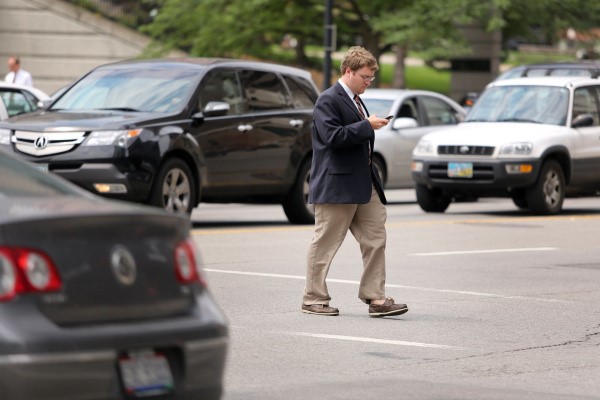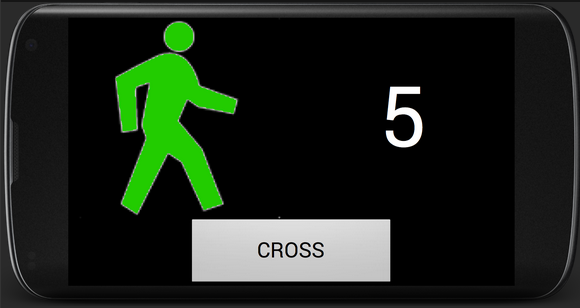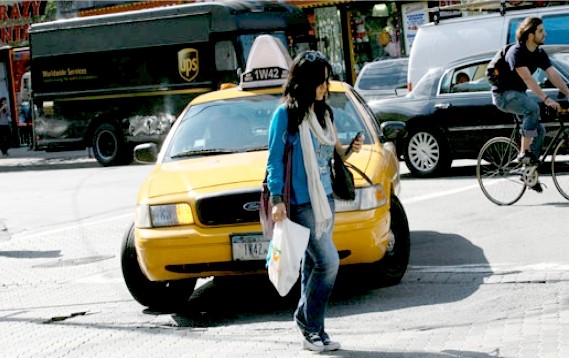Small Business Innovation Research Program Makes Crossing the Street Safer
As drivers and pedestrians alike have become increasingly distracted by their handheld devices, crossing the street safely is not as straightforward as it used to be. So at DOT, we've been thinking, "What if?" What if, while we may not be able to keep pedestrians from using their phones, we could find ways to keep them safer...even while distracted?

What if your smartphone could alert you when it's unsafe to cross the street? And what if it could alert approaching drivers that you were in the crosswalk? That technology would transform your smartphone from a safety detriment into a pedestrian safety asset.
With the growing numbers of pedestrian fatalities in mind, the Federal Highway Administration (FHWA), through DOT's Small Business Innovation Research (SBIR) program, awarded a contract to Savari Inc. to develop a traffic signal interface app for smartphones called SmartCross.
Every year, Volpe announces new SBIR topics for technological innovation using the highest level of expertise in the small business community throughout the United States. SBIR awards support projects like the SmartCross app.
“Since SBIR’s inception, Volpe has helped entrepreneurs develop new and innovative solutions to complex transportation challenges,” said Rachael Sack, DOT’s SBIR program director at Volpe. “The program connects DOT’s most pressing needs with the innovative power of small businesses.”

The SmartCross application interfaces with traffic signal systems that control the traffic lights and receives information about the pedestrian signal. Sending signals between the pedestrian’s phone and the nearest traffic signal box, the app sends an alert to notify pedestrians when they have the signal to cross. In addition to providing an alert when it's safe to walk, the application also gives users the ability to request the pedestrian signal. And, for enhanced safety, the application provides audio, visual, and haptic (typically vibration) feedback to the user, so pedestrians approaching a crosswalk with their heads down will know to stop at the curb.
The SBIR-supported SmartCross application has different modes for pedestrians, bicyclists, visually impaired individuals, and people in wheelchairs, and can be of immense help to the elderly and the physically impaired. For example, the application can request an extension of pedestrian crosswalk time in the event that the pedestrian has not been able to cross the street in the initially designated time.
Drivers can also benefit from this technology. Vehicles equipped with an on-board unit are notified of a pedestrian in an active crosswalk via an in-vehicle display. The screen also displays the colors of the changing light and how much time remains for each color.

Because the app remains running in a smartphone’s background even when the app is not open, you wouldn't even have to remember to turn it on in order to benefit from its safety features. SmartCross is currently under further development but will soon be available to iPhone and Android users.
SmartCross used the majority of SBIR funding in the app’s concept development, focus groups, and design development. Savari also participates in DOT's connected vehicles research program, which is developing the capability to identify threats and hazards on the roadway and communicate this information to drivers over wireless networks.
With support from DOT and the SBIR program, Savari is working towards achieving a vision where technology brings all of the pieces together—vehicle, infrastructure networks, sensors, intelligence, and people—to bring the future of transportation closer to today.
The technology was developed as part of the SBIR program, with the Phase IIB ending in late 2018. On its path to commercialization, it was deployed in the New York City Connected Vehicle Pilot where extensive research was done to understand deployments in GPS challenged locations such as Manhattan. Savari was subsequently acquired by HARMAN, a Samsung company. Following this acquisition, Vulnerable Road User safety has been identified as a key focus area and Savari is in discussions with cellular network operators and automotive Original Equipment Manufacturers (OEMs) on the commercialization aspects.
Today, they are engaged in pre-commercial trials with consortiums such as 5G Automotive Association (5GAA). The SBIR award has helped Savari pioneer key vehicle-to-everything (V2X) technologies that formed a critical piece of intellectual property for the company.

